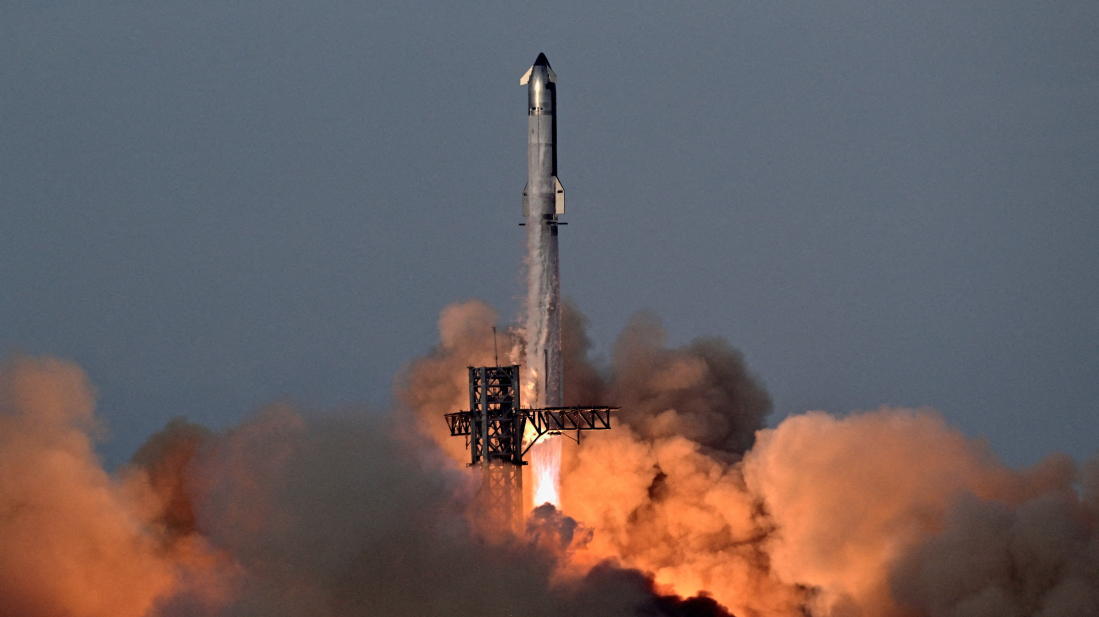Trump discusses diplomacy
U.S. President Donald Trump can maintain both a “good working relationship” with China and a “very strong alliance” with Japan, even as tensio...

SpaceX’s Starship rocket successfully deployed its first batch of mock Starlink satellites and tested new heat shield tiles during its tenth test flight on Tuesday, marking key development milestones after a streak of earlier failures.
The 403-foot-tall (123 m) Starship lifted off around 7:30 p.m. EDT (2330 GMT) from SpaceX’s Starbase in south Texas.
Three minutes later, its towering Super Heavy booster released the Starship upper stage into orbit.
About 30 minutes into the flight, Starship’s “Pez”-like deployment system released eight dummy Starlink satellites for the first time, a critical demonstration for the rocket that underpins SpaceX’s dominant launch business.
Roughly an hour into the flight, Starship underwent a supersonic reentry over the Indian Ocean, testing a new hexagonal heat shield designed to require minimal refurbishment after each mission.
The mission concluded with a vertical, engine-guided landing on the ocean’s surface west of Australia. The Starship then toppled and exploded in a controlled fireball, an expected outcome likely triggered by the flight termination system.
The Super Heavy booster executed a water landing in the Gulf of Mexico instead of returning to the launch tower, demonstrating an alternate landing configuration.
The flight was broadcast live on SpaceX’s webcast, attracting hundreds of thousands of viewers online.
Much is riding on Starship’s success, as NASA selected the rocket to land the first astronauts on the Moon since the Apollo programme, and Elon Musk views it as essential for future missions to Mars.
Despite the progress, several challenges remain, including in-space refuelling demonstrations and ensuring a safe lunar landing.
This flight follows a series of earlier Starship test failures, including explosions during ascent and at landing, making this successful satellite deployment and heat shield test a key milestone in SpaceX’s test-to-failure development strategy.
Returning spacecraft have historically required extensive repairs due to high-speed atmospheric friction.
“There are thousands of engineering challenges that remain, for both the ship and the booster, but maybe the single biggest one is the reusable orbital heat shield,” Musk said on Monday during a SpaceX live stream.
Acting NASA Administrator Sean Duffy congratulated SpaceX on X, writing, “Flight 10’s success paves the way for the Starship Human Landing System that will bring American astronauts back to the Moon on Artemis III.”
NASA awarded SpaceX a contract to develop Starship as the Human Landing System for Artemis III, tasked with returning American astronauts to the lunar surface for the first time in more than 50 years.
The first crewed Artemis mission, currently scheduled for 2027, will use Starship, though analysts expect the date may slip.
SpaceX continues to rapidly build new Starship prototypes at its Starbase complex.
Starship is also critical to SpaceX’s Starlink satellite internet business, which has so far relied on Falcon 9 rockets. The new system is designed to launch larger batches of satellites more efficiently.
Scores of demonstrators gathered outside the Norwegian Nobel Institute in Oslo Tuesday (9 December) to protest against the awarding of this year’s Nobel Peace Prize to Venezuelan opposition leader Maria Corina Machado.
The world’s leading minds and voices will be honoured on Wednesday, 10 December, the anniversary of Alfred Nobel’s death, as Nobel Prizes are presented in Stockholm and Oslo.
In a dramatic Champions League clash at Baku’s Tofiq Bahramov Stadium, Qarabağ grabbed an early lead, but Ajax staged a thrilling comeback to win 4-2.
German Chancellor Friedrich Merz congratulated Azerbaijan and Armenia on their recent peace deal which he said opened an "historic opportunity" for the region.
At least 19 people were killed and 16 injured as two buildings collapased in Morocco's Fes city according to the state news agency.
Pakistan has indicated its openness to forming a regional bloc with Bangladesh without including India. The statement from Islamabad follows comments by Bangladesh’s top foreign affairs adviser, Md Touhid Hossain, that such an arrangement is strategically possible without India.
In a significant shift in its foreign policy, China has unveiled a new policy paper promising no-strings-attached development support to Latin America and the Caribbean, signalling a major upgrade in its engagement with the region.
U.S. President Donald Trump can maintain both a “good working relationship” with China and a “very strong alliance” with Japan, even as tensions have risen between the two countries, the White House said on Thursday.
The United States intends to retain the oil aboard a tanker seized off the Venezuelan coast, White House spokeswoman Karoline Leavitt said on Thursday.
A new proposal in the U.S. Congress aims to remove decades-old restrictions on American assistance to Azerbaijan, reopening a sensitive debate that has shaped Washington’s role in the region for more than thirty years.
You can download the AnewZ application from Play Store and the App Store.

What is your opinion on this topic?
Leave the first comment